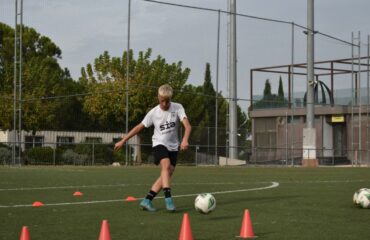Modern football is no longer just a game of talent and technique; today, it is also a discipline deeply influenced by science. Every sprint, every change of direction, and every recovery between matches are designed, measured, and optimized thanks to scientific knowledge. In this context, the science of physical training has become the engine that drives elite football performance.
At SIA Academy, we live this reality every day. As a high-performance center, we understand that sporting success is not achieved through passion alone but through planning based on the science of the human body and its response to effort. Our approach combines technology, data analysis, and scientific methods to shape complete players — physically and mentally.
Table of contents
The evolution of physical training thanks to science
For decades, football training relied mainly on coaches’ experience and intuition. However, in recent years, the science of sport has radically transformed how players prepare. Studies in physiology, biomechanics, and nutrition have made it possible to design personalized programs that maximize performance and reduce the risk of injury.
Today, coaches and fitness trainers use advanced measurement tools such as sports GPS devices, which record speed, distance covered, and workload. This data is analyzed scientifically to adjust each training session according to the player’s needs. Science applied to sport helps us understand which stimuli produce improvements and which can be harmful.
As Ximo, our academy’s physical trainer, explains:
“Modern football demands a balance between intensity and control. Science helps us find that optimal point where the player improves performance without falling into fatigue or injury.”

The invisible force: physiology and performance
The human body is a perfect yet complex machine. Exercise physiology — one of the most important branches of science in sports — studies how the muscular, cardiovascular, and nervous systems respond to training. At SIA Academy, we apply this knowledge to structure load and recovery cycles, ensuring that each player progresses without exceeding their limits.
For example, we know that the development of aerobic and anaerobic power depends on the type and duration of the stimulus. Thanks to science, we can plan specific sessions to improve sprint capacity, endurance, or recovery — all fundamental aspects of modern football. Moreover, constant monitoring through heart rate sensors and lactate analysis allows us to measure progress objectively.
Nutrition and recovery: the key off the field
Physical performance doesn’t end when training does. Science also plays a vital role in recovery and nutrition. Proper diet and restorative rest are the cornerstones of sustainable performance.
At SIA Academy, we take care of every detail of the process. Our team of nutritionists creates balanced meal plans tailored to each player’s energy expenditure. We know, thanks to science, that the type of macronutrients and the timing of consumption can make a huge difference in muscle regeneration. Likewise, we use cryotherapy and mobility work to speed up post-match recovery.
As Ximo says, drawing on his daily experience on the field:
“It’s not enough to train hard; you have to train smart. Science teaches us that recovery is as important as effort. Without rest, there is no progress.”
The mind as a scientific factor
Although many associate physical training solely with the body, the science of sports performance shows that the mind plays an equally — or even more — decisive role. Emotional control, concentration, and psychological resilience directly affect physical performance.
At SIA Academy, we approach mental preparation from a scientific perspective. We use techniques based on neuroscience and sports psychology research to help our players manage pressure and stay motivated. We know the brain is the first muscle that needs training.

Technology and data: the laboratory of modern football
The technological revolution has allowed science and football to merge more than ever. On training fields and in performance labs, data collection is constant. Sensors, high-speed cameras, and biomechanical analysis software provide detailed information about movement efficiency and energy expenditure.
At SIA Academy, we use these tools to analyze every detail of our players. This allows us to personalize training sessions and optimize performance scientifically. For instance, studying internal and external load data shows us when a player needs to reduce intensity or when they are ready for a greater challenge.
The future of football is science
Modern football cannot be understood without science. From training planning to recovery, every decision is backed by data, analysis, and scientific evidence. At SIA Academy, we feel part of this evolution. We firmly believe that developing footballers is not only about teaching them to play but also helping them understand their bodies and minds from a scientific perspective.
Science has transformed football into a more precise, safe, and effective discipline. And as it continues to advance, player performance will keep reaching levels that seemed impossible just decades ago. In our academy, we proudly embrace that transformation because we know that science not only improves performance — it builds the future of football.






